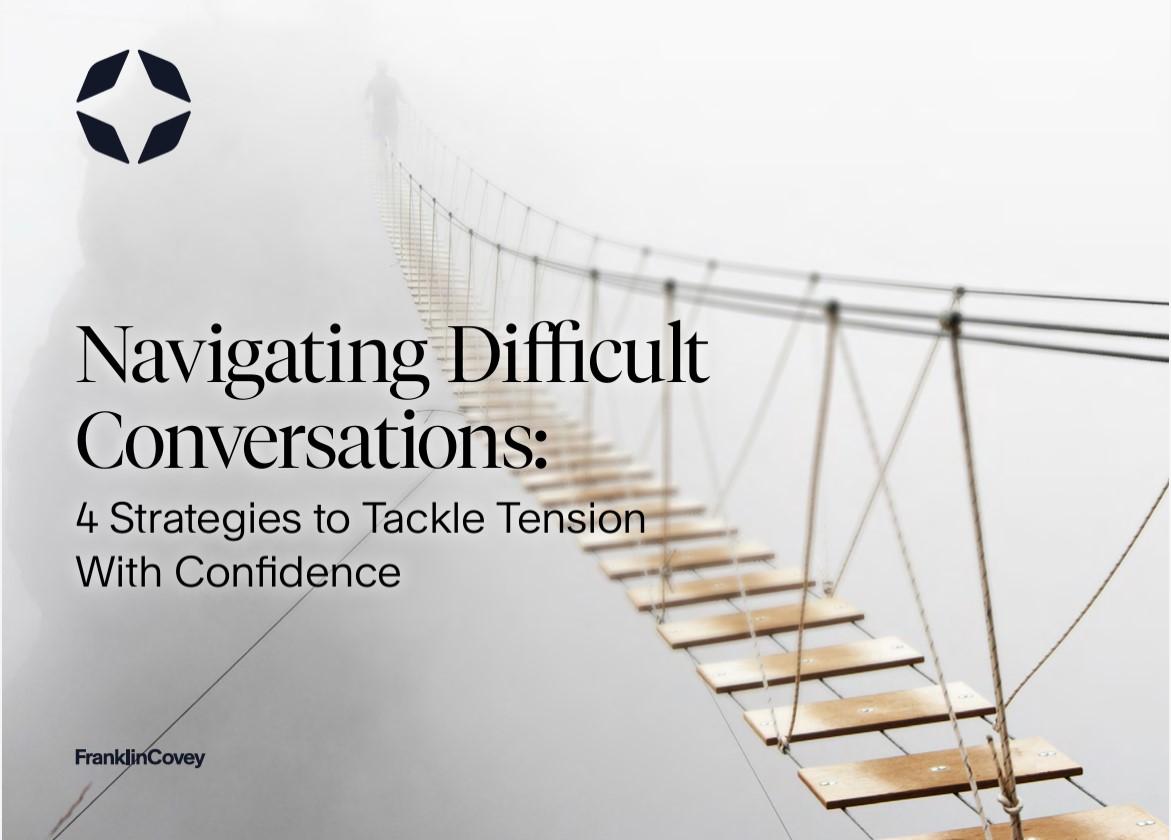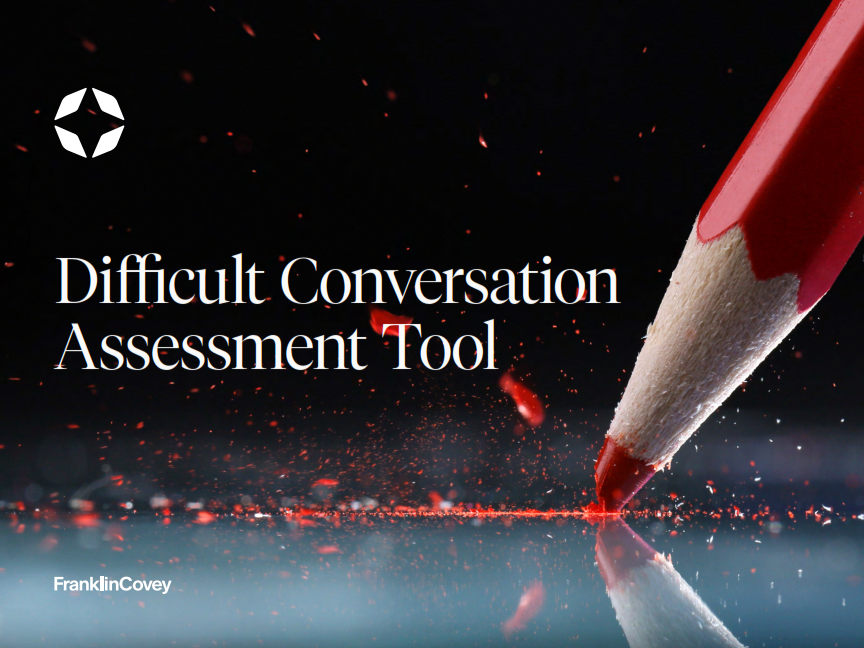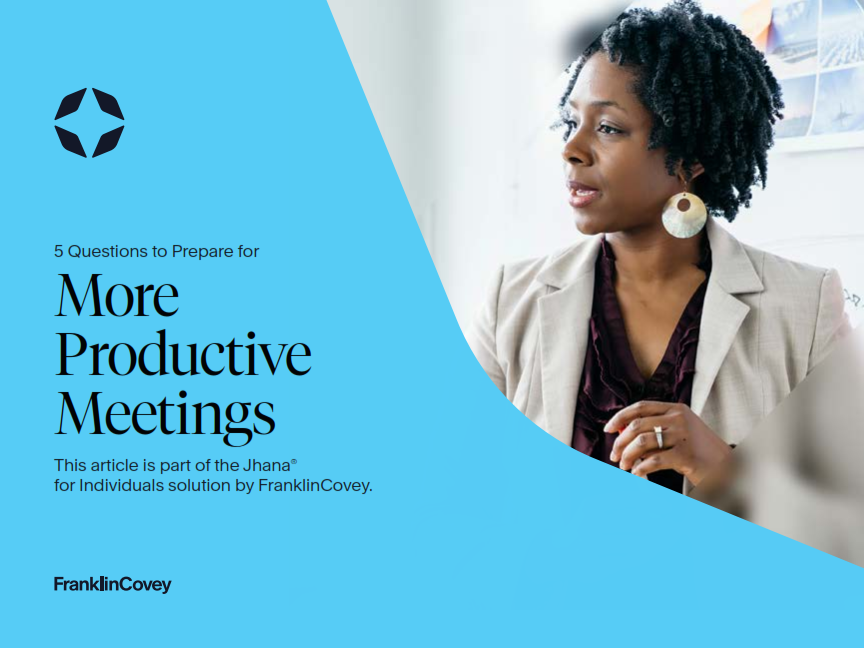
FranklinCovey Resource Center
We enable greatness in people and organizations everywhere.
Tools and Guides
Explore all of our personal and professional development resources for individuals and organizations.
-
 Read More
Read MoreTool: 8 Techniques to Get Beyond the Gatekeeper
Gatekeepers are typically in their role because they are good at it. After all, their job is to protect their leader's time and attention. But this doesn't need to be an adversarial relationship. With a few techniques—and honest communication—we've found that gatekeepers will admit nearly anyone.
-
 Read More
Read MoreGuide: 4 Strategies to Tackle Tension With Confidence
Mastering the art of navigating difficult conversations is a fundamental skill for every member of your organization, but research shows that 65% of individuals stress about handling them. Many people attempt to avoid them, but difficult conversations are inevitable. In fact, it’s likely you’ve already faced a challenging discussion today.
-
 Read More
Read MoreGuide: Mobilize Your Team to Deliver Breakthrough Results.
As the work landscape continues to shift, leaders can keep their approach current and relevant by aligning their leadership style, methods, and skills with today's new world of work.
-
 Read More
Read MoreTool: Difficult Conversations: Assessment
Understanding your conversation style is crucial, especially when it comes to navigating difficult conversations. Learning how you communicate is paramount for effective communication and building meaningful relationships, and even minimizes the chances of miscommunication.
-
 Read More
Read MoreGuide: 4 steps to refine and execute your team goals
Too many leaders set vague goals like “improve customer retention,” leaving their teams unsure of how well they’re doing or even exactly what they’re working toward. This simple formula, from FranklinCovey’s 4 Disciplines of Execution, provides a powerful way to identify “where you are today, where you want to go, and the deadline for reaching that goal.”
-
 Read More
Read MoreGuide: Crucial insights for first-level leaders
First-level leaders are the performance linchpin of organizations, but they’re often thrown into leadership without resources or support. These insights and exercises will make the biggest transition of your career and develop your people into a high-performing team.
-
 Read More
Read MoreGuide: How Effective Leaders Get Results: 7 Ways To Be More Proactive
Leadership often means doing stuff no one else wants to. Broaching touchy topics. Making unpopular decisions. Accepting responsibility. Charting a clear path in a haze of uncertainty. Questioning the status quo. These aren’t exactly easy (or glamorous) undertakings — especially if you’re relatively new to leadership and accustomed to letting others take charge. But the good news is you don’t have to dramatically overhaul your behavior to take more initiative. You just need to make a few
-
 Read More
Read MoreGuide: Listen Like a Leader: 9 Tips to Drive Powerful Conversations
If you’re a leader, it helps to be a good talker. But great communication is actually more about hearing and understanding others than it is about being heard yourself. When you listen well in person or over video meetings, you’ll be able to connect more deeply with your team members, colleagues, and customers. You’ll help advance their thinking — and they’ll advance yours with their ideas and insights. These tips will take your communication skills to the next level, whether you
-
 Read More
Read MoreGuide: 6 Ways to Help Your Team Handle Stress During Times of Change
Change happens. It’s everywhere, it’s increasing in pace, and it’s not going away. As humans, we are wired to react to change to survive. Each of us reacts to change in different ways—even to the same change. While our reactions to change are normal and human, it is our ability to choose our response that sets us apart and allows us to shape our own experiences. Download our guide 6 Ways to Help Your Team Handle Stress During Times of Change.
-
 Read More
Read MoreGuide: The Energy of Change 5 Leadership Behaviors to Drive Collective Action in a Fluid Landscape
Change is constant. And while part of dealing with change is simply accepting there will always be things beyond our control, leaders can use this disruption as an opportunity to create growth and inspire better results in both their people and their organization.
-
 Read More
Read MoreGuide: 5 Steps to Tie Your L&D Budget to Strategic Outcomes
Many organizations have invested in professional training and development opportunities for their people to remain competitive, increase retention, and provide support for employees. However, many L&D programs are falling victim to budget cuts with recent inflation. While many leaders see L&D as a cost and not an investment, there is a way to protect your programs and ensure your people continue to get the support they need to thrive—by defining concrete learning outcomes that align with your
-
 Read More
Read MoreGuide: 7 Steps To Create An Environment Of Trust On Your Team
Most of the world still operates from an outdated style of leadership. This style focuses on control, competing, and self-interest. But the world is changing and this calls for a new style of leadership—Trust & Inspire—where leaders build trust by modeling it. Their job is to go first.
-
 Read More
Read MoreGuide: Help Your Organization Thrive in the New World of Work
Even before the COVID-19 pandemic, many people were redefining their expectations of the workplace and how they might contribute. The pandemic accelerated the shift toward new ways of working that are more flexible, more inclusive, and more supportive of employees’ emotional and social needs. The future of work is no longer a place for everybody, but a space for everybody, with an increased emphasis on the employee experience. The world of work may have changed, but expectations on leaders to p
-
 Read More
Read MoreTool:100+ Questions For Better 1-On-1s With Your Direct Reports
A common mindset is that leaders hold 1-on-1 meetings to monitor people's progress. By only monitoring progress, your leaders miss an opportunity to uncover other issues. When done properly, 1-on-1s can be one of your most powerful tools to engage your people. Download 100+ questions that your leaders can ask their direct reports to engage people.
-
 Read More
Read MoreTool: 80/20 Activity Analyzer
80% of your results will come from 20% of your activities—are you focusing on the right ones? Use our 80/20 Activity Analyzer tool to be more strategic in your process and more successful in your results. Analyze any barrier, evaluate others who have achieved something similar, and use your imagination to determine other activities that might make a difference.
-
 Read More
Read MoreGuide: 6 Key Communication Techniques To Build Trust And Inspire Your Team
The expectations for leaders in the workforce are changing. Leadership today is much more than setting goals and dictating priorities. Your job as a leader is to connect your team to a greater sense of purpose and meaning at work. To do this, communication is key. Leaders must communicate in ways that build trust and inspire their teams to greatness.
-
 Read More
Read MoreTool: How To Communicate Change: A Tool For Leaders
How leaders communicate a change to their team is critical to helping them understand and adapt. All change creates disruption, but leaders can minimize the amount of disruption through effective communication. Through careful preparation, leaders can articulate the change clearly and share a vision of the future with their team.
-
 Read More
Read MoreGuide: Manage Your Energy To Do Your Job Well
Most high-achieving professionals care deeply about their work. They feel a strong sense of responsibility for people and projects and tend to neglect their own needs, especially in stressful times or when you need to adapt to change. If you fit that description, you may be on the path to burnout. To identify areas where you're putting yourself at risk, answer the questions in our guide, then choose one good self-care habit you can start practicing this week.
-
 Read More
Read MoreGuide: 6 Ways Your Leaders Can Build Trust And Avoid Breaking It
A big part of leadership is inspiring teams to meet performance goals. But what determines whether they respond? Often, the answer hinges on the leader's ability to instill or erode trust within their teams. Building trust and inspiring your teams to meet performance goals—while fostering professional growth, productivity, and commitment—are all part of creating a culture that thrives.
-
 Read More
Read MoreGuide: 5 Questions To Prepare For More Productive Meetings
We all know the pain of sitting through boring, unorganized, and downright wasteful meetings. When you calculate the costs of unproductive meetings for your organization, it adds up fast. A little preparation can go a long way when making meetings more productive.

